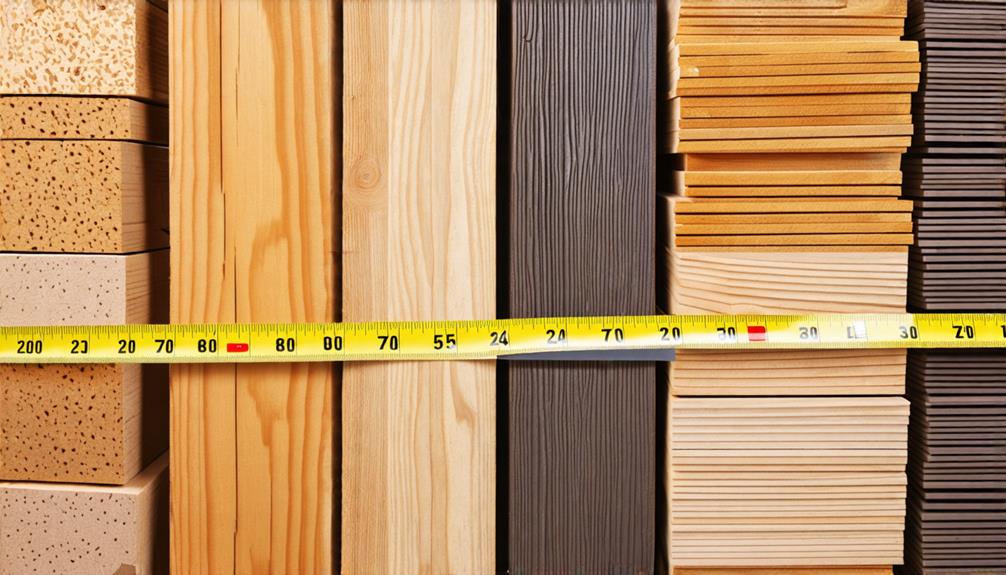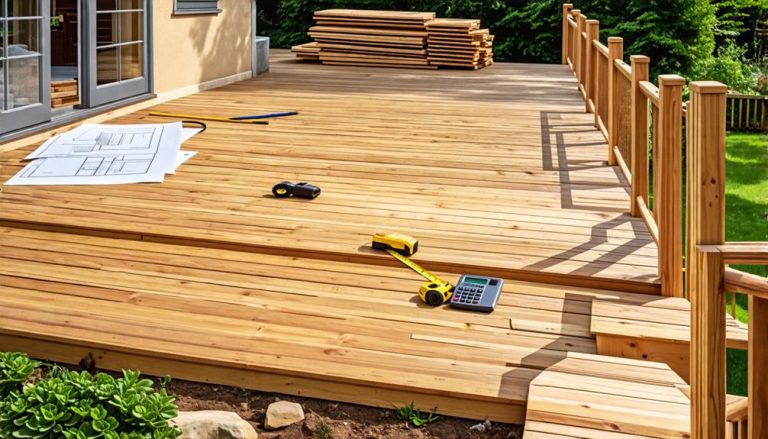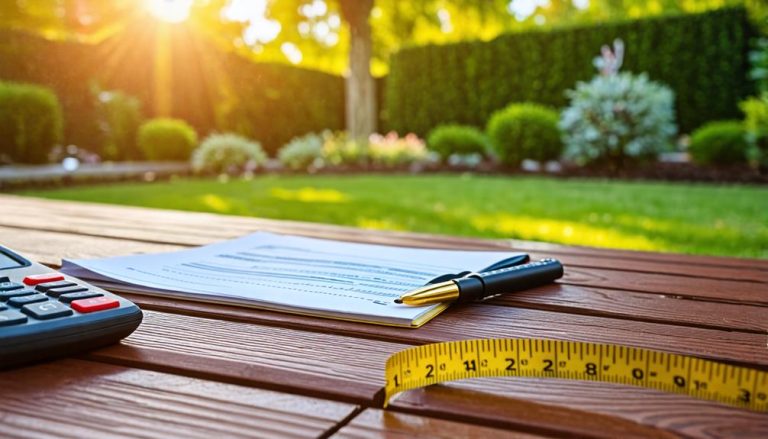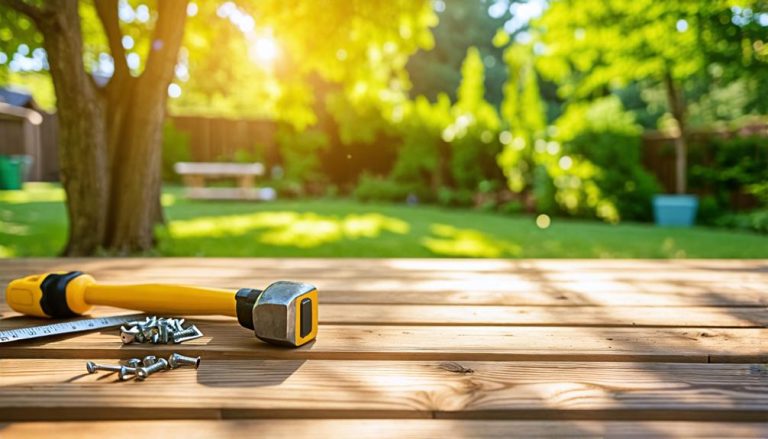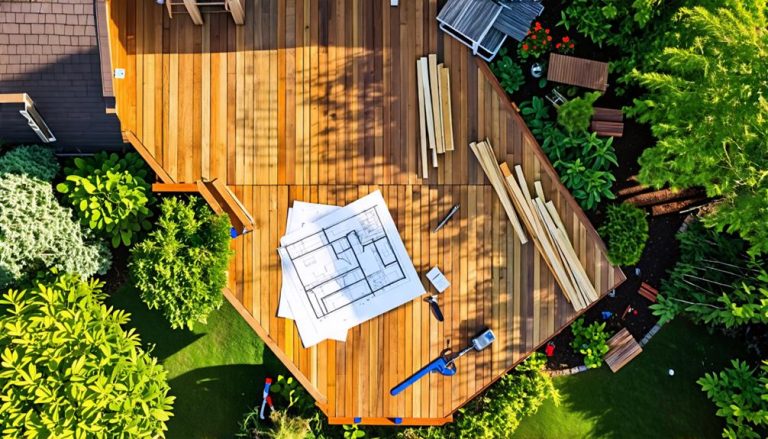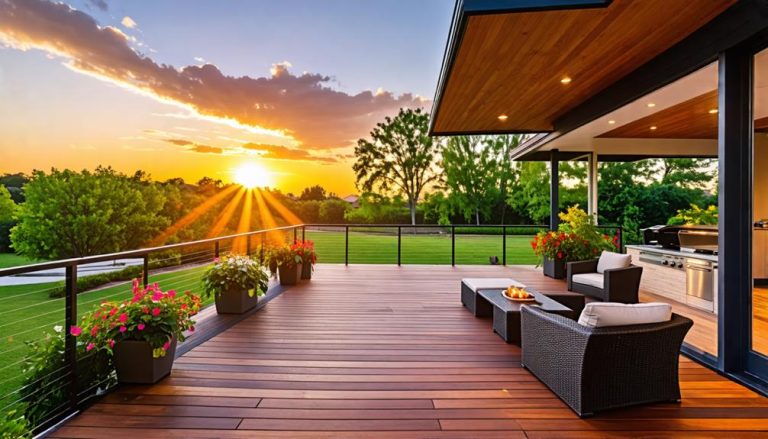What Is the Average Cost of a 20X20 Deck?
A 20×20 deck typically costs between $6,000 and $14,000, depending on various factors. Your choice of materials greatly impacts the price, with pressure-treated lumber being the most affordable option at $15-$25 per square foot, while composite decking ranges from $30-$60 per square foot. Additional expenses include hardware, fasteners, and railings, which can add $1,000-$3,000 to your total. The complexity of your design, labor costs in your area, and any added features like built-in seating or a pergola will also influence the final price. Consider the long-term maintenance costs and potential return on investment when making your decision. Exploring the details of each component will help you make an informed choice for your outdoor living space.
Cost Range for Materials
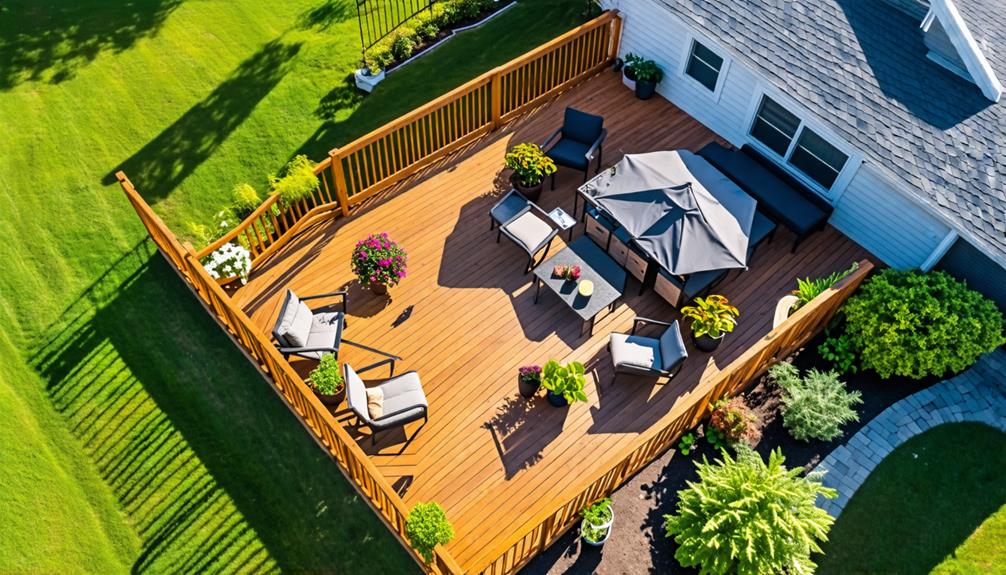
When planning your 20×20 deck, you’ll need to evaluate the cost range for materials, which can differ notably based on your choices. The most substantial decision you’ll face is between lumber and composite decking materials, with pressure-treated pine being the most economical option and high-end composites commanding premium prices.
As part of our custom solutions focus, we guide you in making the best choice that aligns with your personal style and budget. Don’t forget to factor in the costs of essential hardware, fasteners, railings, and balusters, which can add up quickly and impact your overall budget.
Lumber Vs. Composite Options
For a 20×20 deck, you’ll find a significant cost difference between lumber and composite materials. Pressure-treated lumber, the most economical option, typically ranges from $15 to $25 per square foot installed. Cedar and redwood, prized for their natural beauty and resistance to decay, fall in the $30 to $45 per square foot range. These wood options require regular maintenance, including staining or sealing every few years.
Composite decking, on the other hand, comes with a higher initial cost but offers long-term benefits. You can expect to pay between $30 and $60 per square foot for composite materials and installation. While pricier upfront, composites require minimal maintenance and resist fading, staining, and scratching. They’re also splinter-free and won’t warp or rot like traditional wood.
When choosing between lumber and composite, consider your budget, desired aesthetic, and willingness to perform ongoing maintenance. How much time are you willing to invest in upkeep? Do you prefer the natural look of wood or the consistency of composite? Weighing these factors will help you determine which material best suits your needs and preferences for your 20×20 deck project.
Hardware and Fasteners
Beyond the decking material itself, you’ll need to factor in the cost of hardware and fasteners for your 20×20 deck project. These essential components typically include joist hangers, post anchors, screws, nails, and bolts. For a 400-square-foot deck, you can expect to spend between $250 and $500 on hardware and fasteners, depending on the quality and type of materials you choose.
Stainless steel fasteners, while more expensive, offer superior corrosion resistance and longevity, particularly in coastal or high-moisture environments. You’ll need to contemplate the specific requirements of your chosen decking material; for instance, composite decking often necessitates specialized screws designed to prevent mushrooming. How many fasteners will you need? A general rule of thumb is to allocate about 350 screws per 100 square feet of decking. Don’t forget to account for structural fasteners, such as lag bolts for ledger boards and carriage bolts for post connections.
When budgeting, it’s prudent to add a 10-15% contingency for hardware costs to cover any unforeseen needs or adjustments during construction. Remember, investing in high-quality hardware guarantees the structural integrity and longevity of your deck.
Railings and Balusters
Railings and balusters constitute a significant portion of your 20×20 deck‘s material costs. The price range for these components can vary widely depending on the materials you choose and the complexity of the design. For a 20×20 deck, you’ll typically need around 60-80 linear feet of railing, which can cost anywhere from $20 to $150 per linear foot.
Wood railings are often the most economical option, with pressure-treated pine costing $20-$35 per linear foot. Cedar or redwood railings may run $30-$50 per linear foot. If you’re looking for low-maintenance alternatives, consider composite railings at $40-$60 per linear foot or aluminum railings at $50-$100 per linear foot. For a more upscale appearance, stainless steel cable railings can cost $100-$150 per linear foot.
Balusters, the vertical posts supporting the handrail, also contribute to the overall cost. Wood balusters typically cost $1.50-$3 each, while metal balusters range from $5-$15 each. How many balusters will you need? Building codes usually require balusters to be spaced no more than 4 inches apart, so plan accordingly when calculating your materials list.
Benefits

When you decide to invest in a 20×20 deck, you’re not just adding extra square footage to your home. You’re commissioning a custom-built outdoor haven that seamlessly blends your indoor living space with the beauty of nature.
This new addition, crafted with the unmatched expertise and quality materials offered by Dream Decks, provides a versatile area for hosting social gatherings, spending quality time with family, or simply enjoying some quiet solitude.
Additionally, a well-designed and properly maintained deck can drastically increase your property’s value and visual appeal, making it an enticing feature for potential buyers if you ever decide to put your home on the market.
Increased Outdoor Living Space
Adding a 20×20 deck to your home vastly expands your outdoor living space. With 400 square feet of additional area, you’ll have ample room to create a multifunctional outdoor retreat. This generous space allows for various seating arrangements, dining areas, and even zones for different activities. You can easily accommodate a full-sized patio set, complete with a table and chairs for al fresco dining, while still having space for loungers or a conversation area.
Have you considered the versatility this extra space provides? You’ll be able to host larger gatherings, from summer barbecues to intimate evening soirées. The deck can serve as an extension of your indoor living area, seamlessly blending the two environments. Install a grill or outdoor kitchen to enhance your culinary experiences. Add potted plants, hanging baskets, or even a small herb garden to bring nature closer.
For added comfort and extended use, consider incorporating features like a pergola for shade, built-in benches for seating, or a fire pit for cooler evenings. With proper planning, your 20×20 deck can become a true outdoor oasis, substantially enhancing your home’s livability and your quality of life.
Enhanced Property Value
A well-designed 20×20 deck can considerably boost your home’s market value. When you invest in a quality outdoor living space, you’re not just enhancing your lifestyle; you’re also making a smart financial decision. Real estate experts often cite outdoor improvements as one of the most effective ways to increase a property’s appeal and worth.
Consider this: a deck addition can offer a return on investment (ROI) of up to 75%, depending on your location and the materials used. This means that if you spend $20,000 on your deck, you could potentially recoup $15,000 in added home value. How does this compare to other home improvements? Surprisingly well. Kitchen remodels, often considered the gold standard for home upgrades, typically yield a lower ROI of around 60-70%. Additionally, a deck expands your usable living space without the hefty price tag of a full home addition. When potential buyers view your property, they’ll see the deck as an extension of the home, effectively increasing the perceived square footage. This added outdoor space can be a significant selling point, particularly in regions with favorable climates. Have you considered how a deck might set your home apart in a competitive real estate market?
Versatile Entertainment Area
Beyond boosting your property’s value, a 20×20 deck transforms your home into an entertainment hub. You’ll discover that this spacious outdoor addition serves as a versatile area for hosting gatherings, from intimate family dinners to lively summer barbecues. With 400 square feet at your disposal, you can create distinct zones for dining, lounging, and socializing.
Consider incorporating built-in seating along the perimeter, which maximizes space and provides ample room for guests. You might also install a pergola for shade or add a fire pit as a cozy focal point. Have you thought about including an outdoor kitchen? It’s an excellent way to enhance your entertaining capabilities. Don’t forget about lighting options; string lights or recessed deck lighting can extend your enjoyment well into the evening hours.
Your 20×20 deck can adapt to various purposes throughout the year. In spring and summer, it’s perfect for sunbathing or gardening with container plants. During fall, it becomes an ideal spot for watching the changing foliage. Even in winter, with proper weatherproofing and heating elements, you can use your deck for stargazing or enjoying hot cocoa outdoors.
Improved Aesthetics and Appeal
Your home’s curb appeal gets an instant boost with a well-designed 20×20 deck. This outdoor addition not only enhances your property’s visual appeal but also increases its overall value. When constructed with high-quality materials and expert craftsmanship, a deck becomes a seamless extension of your home’s architecture, creating a cohesive and inviting exterior aesthetic.
Consider how different decking materials can complement your home’s style. Wood options like cedar, redwood, or pressure-treated pine offer a classic, natural look, while composite decking provides a modern, low-maintenance alternative. The railing design, whether it’s traditional balusters, sleek cable rails, or tempered glass panels, can dramatically impact the deck’s appearance.
Have you thought about incorporating built-in planters or pergolas to add vertical interest and soften the deck’s lines? Lighting is another integral element in improving aesthetics. Strategically placed LED deck lights, post cap lights, or even string lights can create an enchanting ambiance for evening enjoyment.
Don’t forget about the finishing touches: weatherproof furniture, outdoor rugs, and potted plants can transform your deck into a stylish outdoor living space that enhances your home’s overall appeal.
Maintenance and Upkeep Costs

When considering the maintenance and upkeep costs of your 20×20 deck, you’ll need to factor in regular cleaning, protective treatments, and potential repairs. You should plan for annual power washing and resealing to maintain the deck’s appearance and structural integrity. Over time, you may also encounter expenses related to replacing damaged boards or reinforcing weakened support structures.
| Maintenance Task | Frequency | Estimated Cost |
|---|---|---|
| Power Washing | Annually | $100 – $300 |
| Resealing | Every 2-3 years | $200 – $500 |
| Board Replacement | As needed | $20 – $50 per board |
Regular Cleaning Requirements
Regular cleaning is an essential aspect of a deck’s maintenance and upkeep costs. You’ll need to sweep your deck weekly to remove debris, leaves, and dirt that can accumulate and potentially cause damage.
For a more thorough cleaning, you should plan on power washing your deck at least once a year. This process removes stubborn stains, mildew, and grime that can build up over time.
When power washing, you’ll want to use a low-pressure setting to avoid damaging the wood fibers. How often should you clean between power washes? It depends on your deck’s exposure to the elements and foot traffic. For instance, if your deck is under trees or experiences heavy use, you might need to perform a deeper clean every few months.
Don’t forget to inspect for any loose nails, screws, or boards during your cleaning routine. Are there any signs of rot or insect damage? Address these issues promptly to prevent more extensive and costly repairs down the line. By maintaining a regular cleaning schedule, you’ll extend the life of your deck and potentially save on long-term maintenance costs.
Protective Treatments Needed
Protective treatments are essential for maintaining your deck’s longevity and appearance. You’ll need to apply these treatments regularly to safeguard your investment from the elements, UV rays, and general wear and tear. Typically, you should plan on sealing or staining your deck every two to three years, depending on its exposure to sunlight and moisture.
When choosing a protective treatment, consider your deck’s material. Wood decks often require a water-repellent sealer or a semi-transparent stain to prevent moisture damage and preserve the wood’s natural beauty. For composite decks, you might opt for a UV-resistant sealer to prevent fading and extend the material’s lifespan.
How much will this cost? On average, you can expect to spend between $0.50 and $2.50 per square foot for materials, depending on the quality of the product you choose. For a 20×20 deck, that’s approximately $200 to $1,000 in materials alone. Don’t forget to factor in labor costs if you’re hiring a professional, which can add significantly to the overall expense.
Repair and Replacement
Over time, even well-maintained decks will require repairs and potential replacements. As you plan for the long-term costs of your 20×20 deck, it’s essential to factor in these inevitable expenses.
Typically, you’ll need to address issues such as loose boards, protruding nails, or damaged railings every few years. More significant repairs, like replacing rotted joists or support posts, may be necessary after a decade or more of use.
When budgeting for repairs and replacements, consider the following:
- Annual inspections: Set aside funds for professional evaluations to catch issues early.
- Minor repairs: Allocate $100-$300 annually for small fixes and maintenance tasks.
- Major overhauls: Plan for a substantial renovation or replacement every 15-20 years, potentially costing 50-75% of the original deck’s price.
Frequently Asked Questions
How Long Does It Typically Take to Build a 20X20 Deck?
You can expect to spend about 1-2 weeks building a 20×20 deck, depending on your experience and the complexity of the design. Weather conditions, material availability, and permitting processes may also affect the timeline.
Do I Need a Permit to Construct a 20X20 Deck?
You’ll likely need a permit to build a 20×20 deck. Check with your local building department, as requirements vary by location. They’ll guide you through the process and guarantee your deck meets safety standards.
Can I Install a 20X20 Deck Myself, or Should I Hire Professionals?
You can install a 20×20 deck yourself if you’re handy and have the necessary skills. However, it’s a big project that requires planning, tools, and expertise. Hiring professionals guarantees proper construction and saves you time and effort.
What Foundation Options Are Available for a 20X20 Deck?
You’ve got several foundation options for your 20×20 deck. You can choose from concrete piers, helical piles, or concrete footings. Each has its pros and cons, so consider factors like soil type, climate, and local building codes.
How Does Climate Affect the Lifespan of a 20X20 Deck?
Climate profoundly impacts your deck’s lifespan. You’ll face moisture damage in humid areas, while extreme heat can cause warping. Cold climates lead to freeze-thaw cycles, and UV rays degrade materials. Regular maintenance helps combat these effects.

